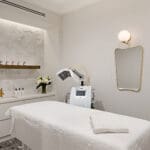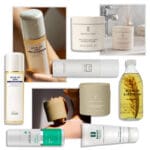Here we are… it’s only April but it feels like July already! On that note I would like to remind everyone to use a broad spectrum sunscreen. This year the FDA is proposing a major overrule in all things sunscreen and SPF related. Currently SPF in the USA is only measured by UVB protection (the rays that cause sunburn). The higher the SPF the longer you can be in the sun without burning or reapplying. However it’s the UVA rays that penetrate deeper and contribute to skin aging and the risk of skin cancer. You can try to read ingredients on every sunscreen label and its mind boggling. All the names and things you’ve never heard of. A little trick I use is to think of “A” as Aging and “B” as Burning. By this summer the FDA will enforce products to disclose the UVA and UVB protection. Not sure what number SPF to use? According to new rules all sunscreen will be broad spectrum protecting us from burning and premature aging, which is great news. All sunscreens must stop at SPF 50 and give warning if they are less than SPF 15. Also “sweat proof” will go to the wayside but “water resistant” will remain. We’ll start seeing new labels soon, which means lots of products will need to be reformulated.
The debate is still going on whether chemical or physical sunscreens are better. In my opinion chemical sunscreens breakdown faster and have to be applied more often, whereas physical sunscreens (containing usually zinc oxide or titanium dioxide) are considered safer and they’ve been around longer. Surely you remember sporting a white painted nose in the 1980’s! This is the type of sunscreen I personally suggest for younger kids. No matter what type of sunscreen you choose to use make sure to bathe your kids at night. This allows their skin to breathe and assures that they won’t have prolonged exposure to chemicals on their body. Keep in mind that sunscreens also have expiration dates and most expire 6-12 months after they’ve been opened. It is best practice to start with fresh products every summer. In Europe and Japan sunscreens are considered “cosmetics” which allows more ingredients to be used in their products. That’s why I personally prefer European sunscreens like those by Institut Esthederm, a French award winning skincare line with exceptional sun care. This is not to say that there aren’t great American sunscreens such as Jan Marini’s Antioxidant SPF 33.
Savvy sun protection is not just about the products you use, it’s also about the application. Apply thoroughly and often! Don’t forget lips, hands, ears, sunglasses to protect your eyes, and a hat to protect your scalp. No matter how good you are about using your sunscreen during the day can you please please please please not forget to remove it at night? Water resistant sunscreens tend to stick to skin like glue. It takes extra effort and extra cleansing to remove all traces. I recommend using a Clarisonic brush with Institut Esthederm’s Gentle Deep Pore Cleanser or our latest and greatest edition the Eve Lom cleanser with muslin cloth system. Whatever type of cleansing you choose be sure to follow with P50. Apply your serum and moisturizer at night to allow the skin to rejuvenate and breathe away from the sunscreen chemicals.
To demystify sunscreen its anti aging effects are only available in daylight and in the sun. At night your skin should be slathered in wonderful serums and creams to recover from a long day of chemical exposure. For those of you that use a day cream with SPF at night also you should seriously reconsider this. You want to limit your exposure to the chemicals and also allow your skin to breathe and regenerate. If it were possible I would add a warning to all sunscreen labels that said “CAUTION: Wear sunscreen only in daylight and remember to remove it at night.” Hopefully the FDA is reading my blog post and we’ll see this advice appear on sunscreens down the line!
Esthetician and Owner of Rescue Spa,



